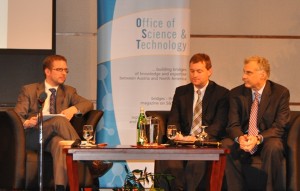bridges vol. 28, December 2010 / Noteworthy Information
The challenge of addressing climate change inspires fierce, divisive debates, pitting science against politics, environmentalism against commerce, and the most powerful nations in the world against their less-developed neighbors. Roger Pielke, Jr. , professor of environmental studies at the University of Colorado , bridges columnist, and a renowned expert on science and public policy, attempts to take on this challenge. In his new book, The Climate Fix: What Scientists and Politicians Won’t Tell You About Global Warming , he seeks to propose a novel, alternative way of looking for solutions for the climatic changes the earth is experiencing.

The Office of Science and Technology at the Embassy of Austria chose the occasion of the publication of this book to invite Roger Pielke, Jr., and two more experts on the issue – David Goldston and Alexander Ochs – for a debate with the audience on global climate-change policy. David Goldston is the director of Government Affairs for the Natural Resources Defense Council and previously served as chief of staff for the chairman of the US House of Representatives’ Subcommittee on Science and Technology. Alexander Ochs works for Worldwatch Institute, directing its Climate and Energy Program.
[Read the rest of the event report on the bridges website]
